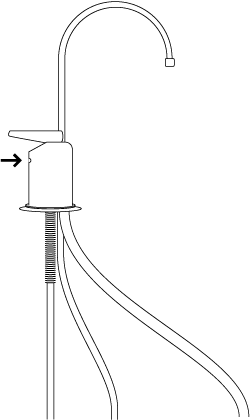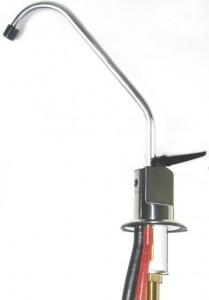Pure Water Annie’s FAQ Series.
Pure Water Gazette Technical Wizard Pure Water Annie Answers All the Persistent Questions about Water Treatment.![pwanniemedium[1]](http://www.purewatergazette.net/blog/wp-content/uploads/2012/05/pwanniemedium1-246x300.jpg)
This week’s topic: Air Gap Faucets.
I’m buying a new undersink water filter. Should I get an air gap faucet with it or a standard faucet?
Standard. Air gap faucets are used only with reverse osmosis units.
Why don’t they use them with filters?
Filters don’t have a drain line. The air gap faucet is mainly about the drain. The “air gap” for the drain is put in the faucet only because that’s a convenient place to locate it. The purpose of the air gap is to prevent backflow from the drain to the RO unit.
Why does the air gap faucet need three tubes instead of one?
See the illustration below. The tube on the left, the one that enters the threaded stem, carries the drinking water to the spout. The other two tubes carry the RO unit’s reject water to drain. The small tube carries the it from the RO unit up to the body of the faucet and the larger tube carries it down the to the drain saddle attached to the home’s drain pipe. The “air gap” occurs between the two tubes. The two drain tubes are not connected inside the faucet base. There’s an “air gap” between them that prevents backflow from the drain to the RO unit.
What’s the purpose of the hole in the faucet body under the handle?
The hole, indicated by the arrow in the picture above, is a drain hole. If the home’s drain is stopped up so that water can’t exit via the large drain tube on the faucet, the drain water simply backs up and dumps out of the faucet and (usually) onto the sink top. This is one of the reasons that people often curse air gap faucets.
How do I fix the problem if water drains onto my sink top?
You have to unstop the undersink drain pipe. Sometimes it’s only a small obstruction in the large faucet drain tube itself. In that case, you can usually fix the problem by removing the 3/8″ (larger) tube from the drain saddle and clearing it. Blowing through the tube often clears it.
Is the gurgling sound I hear when the RO unit runs caused by the air gap faucet?
Usually, yes, but any RO drain can be noisy. Another cause of noisy drains is an improperly placed drain saddle.
Can I replace the air gap faucet with a standard faucet?
Yes, but you’ll have to re-route your drain water. You don’t really have to replace the faucet itself. Simply re-routing the the drain water will get rid of noise and drain water on the countertop. There’s an easy way to use a simple adapter to replace the air gap feature of the faucet with a check valve (one way valve) that will keep water from backing up into the RO unit from a stopped up drain pipe. The check valve may or may not satisfy your local plumbing code but it’s a safe way to keep drain water from backing up into your RO unit.
The red tube carries drain water from the RO unit up to the air gap. The black tube carries the drain water back down to the drain pipe. (Click picture for a larger view.)
What size hole do I need to install an air gap faucet?
Standard faucets need only a 7/16″ hole in the countertop, but the air gap needs at least a 3/4″ hole because of the extra tubes and the spacer (the white object in the picture).
Do new reverse osmosis units come with an air gap faucet?
Some do, some don’t. Some offer options. Pure Water Products’ Black and White RO units, for example, come standard with a non-air gap faucet but with a high quality check valve installed in the drain line. The air gap faucet is available for the asking at no additional charge.
More about air gap faucets, including installation instructions.






